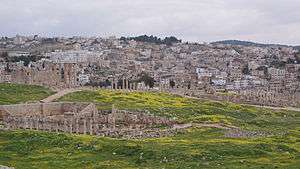Jerash
Coordinates: 32°16′20.21″N 35°53′29.03″E / 32.2722806°N 35.8913972°E
| Jerash مدينة جرش Gerasa (Ancient Greek) | |
|---|---|
| City | |
|
The Roman city of Gerasa and the modern Jerash (in the background). | |
| Nickname(s): Pompeii of the East, The city of 1000 columns | |
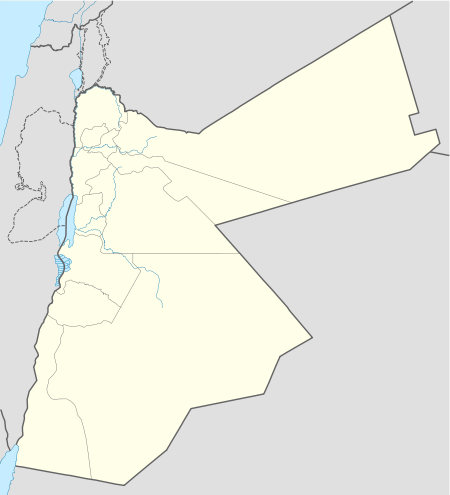 Jerash | |
| Coordinates: 32°16′20.21″N 35°53′29.03″E / 32.2722806°N 35.8913972°E | |
| Country | Jordan |
| Province | Jerash Governorate |
| Founded | 2000 BC. |
| Municipality established | 1910 |
| Government | |
| • Type | Municipality |
| Elevation | 600 m (1,968 ft) |
| Population (2003)[1] | |
| • Total | city (41,500), Municipality (150,000 est) |
| Time zone | GMT +2 |
| • Summer (DST) | +3 (UTC) |
| Area code(s) | +(962)2 |
| Website | http://www.jerash.gov.jo |
Jerash, the Gerasa of Antiquity (Ancient Greek: Γέρασα, Hebrew: גַ'רַש), is the capital and largest city of Jerash Governorate (محافظة جرش), which is situated in the north of Jordan, 48 kilometres (30 mi) north of the capital Amman towards Syria. Jerash Governorate's geographical features vary from cold mountains to fertile valleys from 250 to 300 metres (820 to 980 ft) above sea level, suitable for growing a wide variety of crops.
In the late Ottoman period, the city's name, Jerash, was abandoned and changed to Sakib, yet this was not a permanent development, as the name Jerash reappeared in Ottoman tax registers by the end of 16th century.[2][3]
A strong earthquake destroyed in 749 AD large parts of Jerash, while subsequent earthquakes along with wars and turmoil contributed to additional destruction. The ruins remained buried in the soil for hundreds of years until they were discovered by German Orientalist Ulrich Jasper Seetzen in 1806.[4] In addition to the role of the people of old villages near Jerash, the process of building the modern city of Jerash was mainly done by the resettlement of Circassian Muslims by the Ottoman authorities; the Circassians came to Transjordan from the Caucasus after the Russo-Turkish War of 1877–78. Subsequently a community of people from Syria came to the area at the beginning of the 20th century.
History
Bronze Age
Evidence of settlements dating to the Bronze Age (3200 BC - 1200 BC) have been found in the region.[5][6][7]
Hellenistic period
Jerash is the site of the ruins of the Greco-Roman city of Gerasa, also referred to as Antioch on the Golden River. Ancient Greek inscriptions from the city as well as literary sources from both Iamblichus and the Etymologicum Magnum support that the city was founded by Alexander the Great or his general Perdiccas, who settled aged Macedonian soldiers there (γῆρας - gēras means "old age" in Ancient Greek). This took place during the spring of 331 BC, when Alexander left Egypt, crossed Syria and then went to Mesopotamia.
Roman period
After the Roman conquest in 63 BC, Jerash and the land surrounding it were annexed to the Roman province of Syria, and later joined the Decapolis league of cities. In AD 90, Jerash was absorbed into the Roman province of Arabia, which included the city of Philadelphia (modern day Amman). The Romans ensured security and peace in this area, which enabled its people to devote their efforts and time to economic development and encouraged civic building activity.
Jerash is sometimes misleadingly referred to as the "Pompeii of the Middle East" or of Asia, referring to its size, extent of excavation and level of preservation, since Jerash was never destroyed and buried by a single cataclysmic event, such as a volcanic eruption. Jerash is considered one of the most important and best preserved Roman cities in the Near East.
Jerash was the birthplace of the mathematician Nicomachus of Gerasa (Greek: Νικόμαχος) (c. 60 – c. 120 AD).
In the second half of the 1st century AD, the city of Jerash achieved great prosperity. In AD 106, the Emperor Trajan constructed roads throughout the province, and more trade came to Jerash. The Emperor Hadrian visited Jerash in AD 129-130. The triumphal arch (or Arch of Hadrian) was built to celebrate his visit. A remarkable Latin inscription records a religious dedication set up by members of the imperial mounted bodyguard wintering there.
Byzantine period
The city finally reached a size of about 800,000 square meters within its walls. The Persian invasion in AD 614 caused the rapid decline of Jerash.
Early Muslim period
Despite its decline, the city continued to flourish during the Umayyad period, as shown by recent excavations. In AD 749, a major earthquake destroyed much of Jerash and its surroundings.
Crusader period
During the period of the Crusades, some of the monuments were converted to fortresses, including the Temple of Artemis.
Late Muslim period
Small settlements continued in Jerash during the Ayyubid, Mamluk Sultanate, and Ottoman periods.
Archaeology
Excavation and restoration of Jerash has been almost continuous since the 1920s.
Neolithic age
In August 2015, two human skulls dating back to Neolithic period unearthed in Jerash which forms solid evidence of inhabitance of Jordan in that period especially with the existence of 'Ain Ghazal Neolithic settlement in Amman.
An archaeological excavation team from the University of Jordan has recently unearthed two human skulls that date back to the Neolithic period (7500-5500 BC) at a site in Jerash, the head of the excavation site said Saturday.
The importance of the discovery lies in the rarity of the skulls, as archaeologists estimate that a maximum of 12 sites across the world contain similar human remains, according to Maysoon Nahar, the dean of the university’s archaeology and tourism faculty.[8]
Greco-Roman period
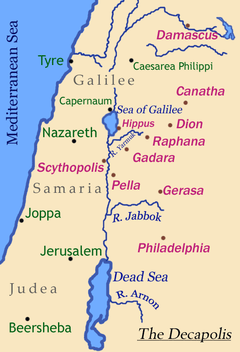

Remains in the Greco-Roman Jerash include:
- Numerous Corinthium columns
- Hadrian's Arch
- The circus/hippodrome
- The two large temples (dedicated to Zeus and Artemis)
- The nearly unique oval Forum, which is surrounded by a fine colonnade,
- The long colonnaded street or cardo
- Two theatres (the Large South Theatre and smaller North Theatre)
- Two communal baths, and a scattering of small temples
- A large Nymphaeum fed by an aqueduct
- An almost complete circuit of city walls
- A water powered saw mill for cutting stone
- Two large bridges across the nearby river.
Most of these monuments were built by donations of the city's wealthy citizens. The south theatre has a focus in the centre of the pit in front of the stage, marked by a distinct stone, and from which normal speaking can be heard easily throughout the auditorium. From AD 350, a large Christian community lived in Jerash, and between AD 400-600, more than thirteen churches were built, many with superb mosaic floors. A cathedral was built in the 4th century. An ancient synagogue with detailed mosaics, including the story of Noah, was found beneath a church. The use of water power to saw wood or stone is well known in the Greek and Roman world, the invention in Greece occurring in the 3rd century BC. They converted rotary movement from the mill to linear motion using a crankshaft and good examples are known from Hierapolis and Ephesus to the north. The mill is well described in the visitors centre, and is situated near the Temple of Artemis.
Modern Jerash
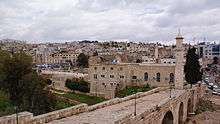
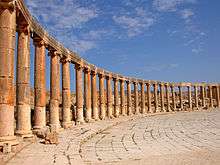
Jerash has developed dramatically in the last century with the growing importance of the tourism industry to the city. Jerash is now the second-most popular tourist attraction in Jordan, closely behind the splendid ruins of Petra. On the western side of the city, which contained most of the representative buildings, the ruins have been carefully preserved and spared from encroachment, with the modern city sprawling to the east of the river which once divided ancient Jerash in two.
Territorial expansion
Recently the city of Jerash has expanded to include many of the surrounding villages, including Souf, Dairelliat, Thougretasfour, Jaba, Aljbarat and Majar. Other important villages in the governorate include: Kitteh, Sakib, Nahlé, Burma, Mustabah, Jubba, Raimoun (biblical Ramoth-Gilead), Kufr Khall, Balila, and Qafqafa.
Demographic evolution
In addition to inhabitants of old villages, Jerash became a destination for many successive waves of foreign migrants. The first wave started during the late 29th century with groups of Circassians, followed during the first half of the 20th century by Syrians (Shwam), all camping near the old ruins. The new immigrants have been welcomed by the local people and settled down in the reemerging city. Later, Jerash also witnessed waves of Palestinian refugees who flowed to the city in 1948 and 1967.
Jerash has an ethnically diverse population, with the majority being Arabs. Circassians and Armenians also live there in a slightly larger percentage compared to other cities in Jordan. The majority of Jerash's population are Muslims. However, the percentage of Christians (Orthodox and Catholics) in Jerash city is also among the highest in Jordan.
According to the Jordan national census of 2004, the population of Jerash City was 31,650 and was ranked as the 14th largest municipality in Jordan. The estimated population in 2010 is about 42,000. The National census of 2004 showed that the population of the province of Jerash Governorate was 153,650.[9] 78,440 (51%) of the population was urban and 75,162 was rural. Jordanian citizens made up 87.1% of the population of Jerash Governorate. The male to female ratio was 51.48 to 48.51.[10] Jerash Governorate has the second highest density in Jordan (after Irbid Governorate).
Culture and entertainment
Since 1981, the old city of Jerash has hosted the Jerash Festival of Culture and Arts,[11] a three-week-long summer program of dance, music, and theatrical performances. The festival is frequently attended by members of the royal family of Jordan and is hailed as one of the largest cultural activities in the region.
In addition performances of the Roman Army and Chariot Experience (RACE) were started at the hippodrome in Jerash. The show runs twice daily, at 11am and at 2pm, and at 10am on Fridays, except Tuesdays. It features forty-five legionaries in full armour in a display of Roman army drill and battle tactics, ten gladiators fighting "to the death" and several Roman chariots competing in a classical seven-lap race around the ancient hippodrome.
Economy
Jerash's economy depends largely on the tourists who visit the ancient city. It is also an agricultural city with over 1.25 million olive trees in the Governorate.[12] However, the location of Jerash, being just half an hour ride from two of the largest cities in Jordan, Amman and Irbid, contributed to the slowing down of Jerash's development, as investments tend to go to the larger cities. Jerash Private University is the only university in Jerash and is located on the highway that connects Jerash to Amman, in the south eastern suburbs of the town.[13]
Tourism
According to "Jordan Times", the number of tourists who visited the ancient city of Jerash reached 214,000 during 2005. Director of Jerash Antiquities Department Mohammad Balawneh said that the number of non-Jordanian tourists was 182,000 last year, adding that the sum of entry charges reached JD900,000.[14] The Jerash Festival of Culture and Arts is an annual celebration of Arabic and international culture during the summer months. Jerash is located 46 km north of the capital city of Amman. The festival site is located within the ancient ruins of Jerash, some of which date to the Roman age (63 BC).[15] Jerash Festival is a festival which features poetry recitals, theatrical performances, concerts and other forms of art.[16] In 2008, authorities launched Jordan Festival, a nationwide theme-oriented event under which Jerash Festival became a component.[17] however the government revived the Jerash Festival as the "substitute proved to be not up to the message intended from the festival."
Gallery
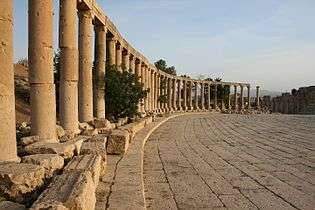 Oval Forum
Oval Forum The South Gate
The South Gate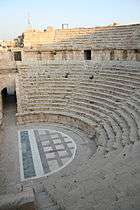 North Theater
North Theater The cardo maximus
The cardo maximus- The South Theatre
 The hippodrome
The hippodrome.jpg) Enriched mouldings on the Temple of Artemis
Enriched mouldings on the Temple of Artemis Northern Tetrapylon, Jerash
Northern Tetrapylon, Jerash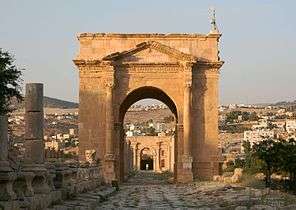 North Tetrapylon, Jerash
North Tetrapylon, Jerash Mosaic at the Christian Church
Mosaic at the Christian Church View of Columns at Jerash
View of Columns at Jerash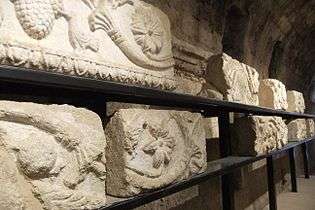 Ornamentation, Jerash
Ornamentation, Jerash Inside Jerash
Inside Jerash Jerash ornamentation
Jerash ornamentation Jerash ornamentation
Jerash ornamentation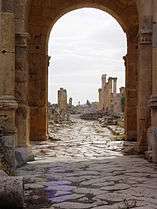 Inside Jerash
Inside Jerash Inscriptions at Jerash
Inscriptions at Jerash
See also
References
- ↑ "بلدية جرش | جرش في سطور". Jerash.gov.jo. Retrieved 2013-09-15.
- ↑ Zeitschrift des Deutschen Palästina-Vereins. Wiesbaden [etc.]: O. Harrassowitz [etc.]. Germany. 1988. p. 187
- ↑ Prawer, Joshua (1980). Crusader Institutions. Oxford: Calarendon Press. ISBN 0-19-822536-9. p.477
- ↑ Reisen, ed. Kruse, 4 vols, Berlin, 1854
- ↑ McGovern, Patrick E.; Brown, Robin (1986). Late Bronze & Early Iron Ages of Central. UPenn Museum of Archaeology. p. 6. ISBN 978-0-934718-75-2.
- ↑ Nigro, Lorenzo (2008). An Early Bronze Age Fortified Town in North-Central Jordan. Preliminary Report of the First Season of Excavations (2005). Lorenzo Nigro. p. 52. ISBN 978-88-88438-05-4.
- ↑ Steiner, Margreet L.; Killebrew, Ann E. (2014). "Main Settlements of the North Jordan Uplands". The Oxford Handbook of the Archaeology of the Levant: c. 8000-332 BCE. OUP Oxford. ISBN 978-0-19-166255-3.
- ↑ "Two human skulls dating back to Neolithic period unearthed in Jerash". 15 August 2015. Retrieved 24 November 2016.
- ↑ Jordan National Census, Arabic Archived April 10, 2008, at the Wayback Machine.
- ↑ Jordan Census Data 2004 Archived July 22, 2011, at the Wayback Machine.
- ↑ Jerash Festival Of Culture & Arts مهرجان جرش للثقافة والفنون
- ↑ "صحيفة الرأي :: الرئيسية". Retrieved 24 November 2016.
- ↑ "Jerash Private University". Retrieved 24 November 2016.
- ↑ Jerash tourism figures reviewed. (2006, Jan 05). Info - Prod Research (Middle East). Retrieved from http://search.proquest.com/docview/457494325
- ↑ Schneider, I., & SoKnmez, S. (1999). Exploring the touristic image of jordan. Tourism Management, 20, 539-542.
- ↑ Jerash festival to be revived. (2011, Mar 07). Jordan Times. Retrieved from http://search.proquest.com/docview/855638491
- ↑ Jerash festival, (2011, Jun 19). McClatchy - Tribune Business News. Retrieved from http://search.proquest.com/docview/872459474
External links
| Wikimedia Commons has media related to Jerash. |
| Wikivoyage has a travel guide for Jerash. |
- BiblePlaces.com
- A brief history and some photographs
- Photos of Jerash
- 360 degrees panorama of Jerash
- Over 230 pictures of the ancient site
- Jerash on Jordanian Postage Stamps
- The Mosaics of Jerash
- Photos Jerash at Pasaporteblog.com (Spanish)
- Jerash (Gerasa) - photo gallery
- Brown, J., E. Meyers, R. Talbert, T. Elliott, S. Gillies. "Places: 678158 (Gerasa/Antiochia ad Chrysorhoam)". Pleiades. Retrieved March 8, 2012.
| Rank | Name | Governorate | Pop. | ||||||
|---|---|---|---|---|---|---|---|---|---|
| Amman Zarqa |
1 | Amman | Amman Governorate | 1,349,260 |  Irbid  Russeifa | ||||
| 2 | Zarqa | Zarqa Governorate | 502,900 | ||||||
| 3 | Irbid | Irbid Governorate | 313,800 | ||||||
| 4 | Russeifa | Zarqa Governorate | 289,800 | ||||||
| 5 | Al Quwaysimah | Amman Governorate | 176,400 | ||||||
| 6 | Wadi as-Ser | Amman Governorate | 158,900 | ||||||
| 7 | Tilā' al-'Alī | Amman Governorate | 147,400 | ||||||
| 8 | Ajloun | Ajloun Governorate | 125,000 | ||||||
| 9 | Aqaba | Aqaba Governorate | 111,600 | ||||||
| 10 | Khuraybat as-Sūq | Amman Governorate | 110,600 | ||||||
